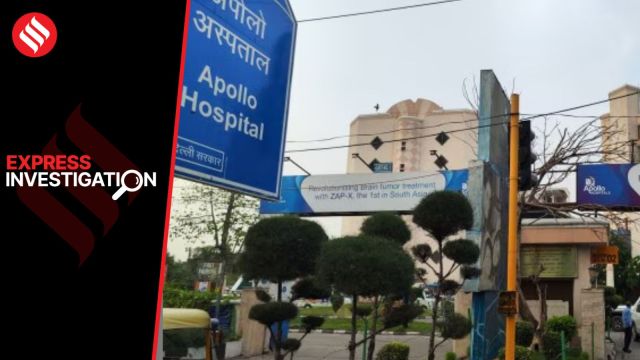Kaunain Sheriff M is an award-winning investigative journalist and the National Health Editor at The Indian Express. He is the author of Johnson & Johnson Files: The Indian Secrets of a Global Giant, an investigation into one of the world’s most powerful pharmaceutical companies. With over a decade of experience, Kaunain brings deep expertise in three areas of investigative journalism: law, health, and data. He currently leads The Indian Express newsroom’s in-depth coverage of health. His work has earned some of the most prestigious honours in journalism, including the Ramnath Goenka Award for Excellence in Journalism, the Society of Publishers in Asia (SOPA) Award, and the Mumbai Press Club’s Red Ink Award. Kaunain has also collaborated on major global investigations. He was part of the Implant Files project with the International Consortium of Investigative Journalists (ICIJ), which exposed malpractices in the medical device industry across the world. He also contributed to an international investigation that uncovered how a Chinese big-data firm was monitoring thousands of prominent Indian individuals and institutions in real time. Over the years, he has reported on several high-profile criminal trials, including the Hashimpura massacre, the 2G spectrum scam, and the coal block allocation case. Within The Indian Express, he has been honoured three times with the Indian Express Excellence Award for his investigations—on the anti-Sikh riots, the Vyapam exam scam, and the abuse of the National Security Act in Uttar Pradesh. ... Read More
Court set bed quota for poor patients at Delhi Apollo, hospital uses only one-fifth
Severe shortfall in commitment hospital made to get land lease for Re 1; hospital says will provide details in court, deliver quality care to eligible EWS patients.
 SC has asked hospital to submit bed strength, OPD records. (Express photo by Abhinav Saha)
SC has asked hospital to submit bed strength, OPD records. (Express photo by Abhinav Saha)On March 25, the Supreme Court warned Indraprastha Apollo in Delhi that it would direct the All India Institute of Medical Sciences (AIIMS) to take over the premier private hospital’s management if it does not fulfill its land lease commitment given to the state government to provide free treatment to poor patients.
That warning wasn’t without reason.
The hospital assigned, on an average each year, just an estimated 17 per cent of the beds it was mandated to use for patients in the Economically Weaker Section (EWS) — across a period of 12 years. An investigation of data from company records reviewed by The Indian Express show that this ranged from barely 20.87 per cent in Financial Year (FY) 2018-19 to a low of 12.01 per cent in FY 2014-15.
The data shows that between financial years 2012-13 and 2023-24, a total of 2,97,555 patients accessed free services at the hospital: 88 per cent in the Out-Patient Department (OPD), which mostly involves consultation, and 12 per cent at the In-Patient Department (IPD) for hospitalisation. Only 2,997 patients on an average per year accessed treatment in the IPD, which would entitle them to a bed, the data shows.
Under terms of the lease agreement, based on which it was handed 15 acres of prime land on the Delhi-Mathura road for just Re 1 a month, the hospital had to provide “free facilities of medical, diagnostic and other necessary care” through not less than one-third of the total capacity of 600 beds.

Bed occupancy rate is a crucial indicator that hospitals use to track how effectively their beds are being utilised over time. At Apollo Hospitals, official records show this rate is calculated by dividing Total Occupied Bed-days by Total Operating Bed-days. Given the High Court-mandated quota of 200 beds, Indraprastha Apollo should ideally have 6,000 Total Operating Bed-days per month reserved for EWS patients (200×30). But over a 12-year period, records show, the average number of Total Occupied Bed-days for EWS patients was just 1,023 — bringing the average bed occupancy rate to a mere 17.05 per cent.
An illustrative example: for the latest year 2023-24, Average Length of Stay at Apollo, as per company records, was 3.41 days. An average of 361 EWS patients were admitted each month to the IPD at Apollo Delhi. So, this resulted in approximately 1,231 Total Occupied Bed-days per month (361×3.41). Therefore, the EWS occupancy rate — derived by dividing Total Occupied Bed-days (1,231) by Total Operating Bed-days (6,000) — stood at 20.5 per cent for FY 2023-24 (see chart).
The Supreme Court’s warning stems from an order passed by the Delhi High Court on September 22, 2009, that at least 200 beds at the hospital must be reserved for patients from the EWS. “Despite lapse of more than 15 years there has been hardly any implementation of the conditions of the agreement providing for free treatment to indoor and outdoor patients,” the Delhi High Court had said in 2009. Referring to two reports submitted by a committee it had set up on the issue, the High Court stated that they “clearly show that the IMCL has flouted the conditions with impunity”.
Data shows that in FY 2012-2014, an average of 164 EWS patients were admitted each month, with an average occupancy rate of just 13 per cent. Between FY 2015 and FY 2019, as average monthly EWS admissions climbed to nearly 287, the average occupancy rates rose to 19.7 per cent. In the pandemic years — FY 2020 and FY 2021 — when EWS admissions dipped to an average of 199 per month, average occupancy rates dropped back to 13 per cent. However, the post-pandemic period witnessed a slight recovery. By FY 2022 and FY 2023, average monthly EWS admissions rebounded to 335, with average occupancy rates returning to 20.4 per cent.
The Indian Express sought a detailed response from Apollo Hospital, including specific details on the average length of stay for EWS patients admitted to the hospital and the total number of EWS beds earmarked. In its reply, the company said: “The matter concerning EWS treatment at Indraprastha Medical Corporation Ltd is sub-judice before the Hon’ble Supreme Court. All details will be provided to the Hon’ble court as per requirement. As a patient-first healthcare provider, Indraprastha Medical Corporation Ltd remains committed to delivering quality care to all, including eligible EWS patients.”
Sources in the hospital indicated that the EWS occupancy rate could be low because only approximately 130-150 EWS beds are available, against the 200 mandated by the Delhi High Court.
Company records also show that a Nodal Medical Officer appointed by the Directorate of Health Services of the Delhi government has to be “permanently stationed in the Hospital to support, guide and monitor the treatment of patients referred by the Government”. This indicates that a significant proportion of patients are those being referred by Delhi government hospitals.
Records also show that the company has “made representations before the Government of NCT of Delhi to allow the Company to extend free treatment including medicines and consumables up to 10 per cent IPD and 25 per cent OPD as applicable to other hospitals”. If this proposal is accepted, Apollo Hospital would no longer be bound to maintain 200 EWS beds — instead, it would be legally required to provide just around 70 beds, marking a significant shift in its obligation to serve economically weaker sections. “The financial impact in the matter can be quantified only after the final decision by the Hon’ble Supreme Court of India,” the company has told its investors, records show.
During hearings before the Delhi High Court, the hospital had contended that it was meant to be a “self-generating project” in which the cost of free services, if any, to be rendered to the poor and needy would have to be generated from revenue earned commercially, keeping a balance between the two activities for viability.
During High Court hearings, the hospital disowned any responsibility to provide free medical aid to poor and needy. It stated that unlike government hospitals and charitable institutions, IMCL, the public limited company that runs the hospital, was answerable to investors and financial institutions supporting it. It also said that as a “humanitarian gesture”, it had offered to start a free treatment facility for poor patients sponsored by the Delhi government “on a pro rata basis”.
The Supreme Court’s warning on March 24 this year came on an appeal filed by IMCL, challenging the Delhi High Court ruling of September 2009. The High Court had ruled that “there has been hardly any implementation of the conditions of the agreement providing for free treatment to indoor and outdoor patients” and cited “reports which clearly show that the IMCL has flouted the conditions with impunity”.
According to the Supreme Court order, the Centre and Delhi government have to set up a joint inspection team to check if the poor are being treated free of cost or the land “has been grabbed for private interest”. The report has to be submitted to the apex court in four weeks.
The Supreme Court has also allowed the hospital to explain its stand in an affidavit, directing it to submit the existing total bed strength and records of OPD patients for the past five years. “The affidavit will explain how many poor patients on the recommendation of the state authorities were provided indoor and outdoor treatment in the last five years,” the Supreme Court said.
It was on April 21, 1988, that the Delhi government and IMCL entered into lease agreement to establish a multi-disciplinary super specialty hospital for land in Jasola village along the Delhi-Mathura road. The Delhi government has a 26 per cent stake in the hospital with a total investment on its part of more than Rs 38 crore.



- 01
- 02
- 03
- 04
- 05




























